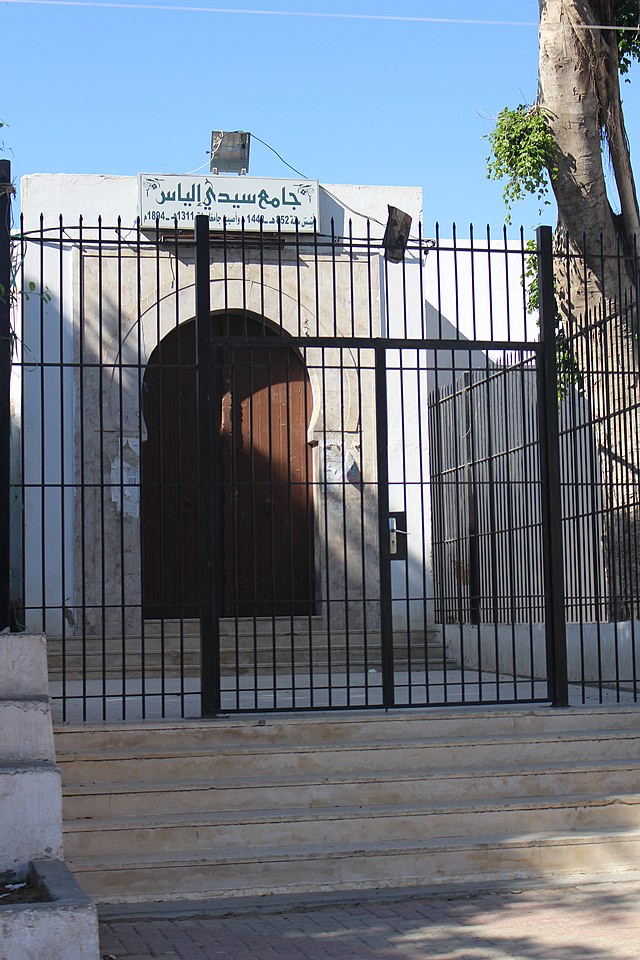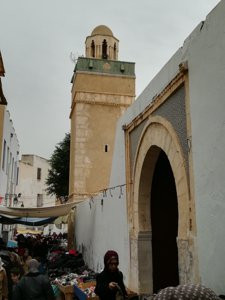Sidi Elyes Mosque
History
Unfortunately, nothing is known about this monument's past. His minaret was renovated during the rule of the Hafsid prince Abu Omar Othman (1485–1488), according to an inscription discovered near the southern facade of the building. The inventory of religious monuments compiled by students of the military academy at Bardo in 1857 is the only other record of its past.
The Sidi Elyes mosque received three renovations in the 20th century, in 1960, 1969, and 1985. To strengthen the mosque's structure, columns from the Zied Palace were brought back during the 1969 construction.
The name Sidi Elyes is said to be derived from the name of a Turkish captain who was interred inside the mosque. However, this theory has no archaeological support.
Urban and Architectural
A prayer room, an imam's room, and a minaret at the southwest corner make up the mosque. On the east, north, and south sides, three patios encircle the structure.
On the east side, the primary door leads out onto Sidi Abbès Street. It stands out thanks to its traditional Ottoman design. The door measures 2.5 meters wide by 3 meters long. It provides access to the mosque's whole east patio, which is wide (30 meters).
The mosque's oldest component is the minaret. It is roughly 14 meters high, 3 meters on each side, and has a square shape. It is made up of a base of 10.5 meters and a hexagonal portion measuring 2.8 meters that is topped by a dome.
Description
According to Mahmoud Megdiche, the mosque is situated in the "Houmet Al Hisar" (literally, the quarter of the embargo), also known as "Haret el Sonnaa" or the quarter of the laborers. This neighborhood is situated in the southwest corner of the Medina. The neighborhood where the mosque is located is regarded as one of the most important districts of the medina because it is the closest to the kasbah, which gave it a significant economic role. It is bordered on the south by the main square of the kasbah, on the west by Borj El Ksar street, on the north by Amilcar Street, and on the east side by Sidi Abbes street. Additionally, the majority of the medina's craftspeople have lived there for many years.
References
Lotfi AbdelJawed, Faouzi Mahfoudh (2016). Corpus of Arabic inscriptions of Islamic monuments of Sfax. Sfax: Dar El Amal. pp. 137–140.
Details
الموقع
Sfax, Tunisia
المالك / المتبرع
The Hafsid prince Abu Omar Othman
تاريخ البناء
15th century
الرسومات المعمارية
الخريطة
History
Unfortunately, nothing is known about this monument's past. His minaret was renovated during the rule of the Hafsid prince Abu Omar Othman (1485–1488), according to an inscription discovered near the southern facade of the building. The inventory of religious monuments compiled by students of the military academy at Bardo in 1857 is the only other record of its past.
The Sidi Elyes mosque received three renovations in the 20th century, in 1960, 1969, and 1985. To strengthen the mosque's structure, columns from the Zied Palace were brought back during the 1969 construction.
The name Sidi Elyes is said to be derived from the name of a Turkish captain who was interred inside the mosque. However, this theory has no archaeological support.
Urban and Architectural
A prayer room, an imam's room, and a minaret at the southwest corner make up the mosque. On the east, north, and south sides, three patios encircle the structure.
On the east side, the primary door leads out onto Sidi Abbès Street. It stands out thanks to its traditional Ottoman design. The door measures 2.5 meters wide by 3 meters long. It provides access to the mosque's whole east patio, which is wide (30 meters).
The mosque's oldest component is the minaret. It is roughly 14 meters high, 3 meters on each side, and has a square shape. It is made up of a base of 10.5 meters and a hexagonal portion measuring 2.8 meters that is topped by a dome.
Description
According to Mahmoud Megdiche, the mosque is situated in the "Houmet Al Hisar" (literally, the quarter of the embargo), also known as "Haret el Sonnaa" or the quarter of the laborers. This neighborhood is situated in the southwest corner of the Medina. The neighborhood where the mosque is located is regarded as one of the most important districts of the medina because it is the closest to the kasbah, which gave it a significant economic role. It is bordered on the south by the main square of the kasbah, on the west by Borj El Ksar street, on the north by Amilcar Street, and on the east side by Sidi Abbes street. Additionally, the majority of the medina's craftspeople have lived there for many years.





